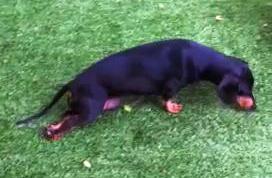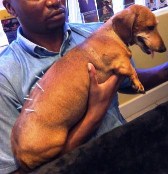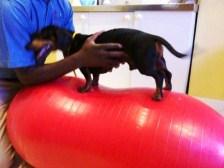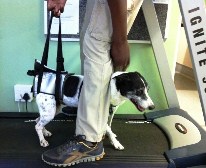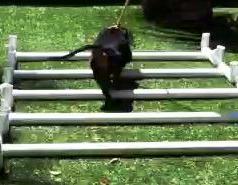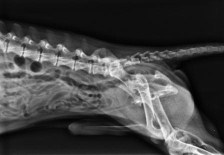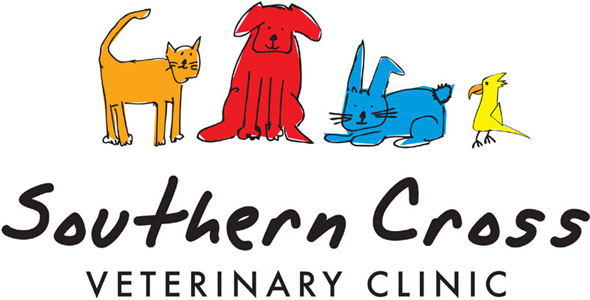

Spotlight on...Intervertebral Disc Disease
What is Intervertebral Disc Disease?
Intervertebral Disc Disease (IVDD) is the term used to describe herniation or rupture of one or more of the discs that are found between the vertebrae (spinal bones). These discs lie directly beneath the spinal cord and act like cushions between the vertebrae, allowing movement and absorbing shocks. Each disc is made up of an outer ring made of fibrous material (the annulus fibrosus) and an inner ring made of jelly-like material (the nucleus pulposus). In most dogs the intervertebral discs degenerate gradually over the course of a lifetime.
There are two types of Intervertebral Disc Disease and in both types one or more of the discs has become abnormal and incapable of withstanding normal forces. In Type I IVDD a sudden, large tear appears in the degenerated, weak outer layer of the disc and the inner layer which has become hard due to dehydration explodes up into the spinal canal. This causes swelling and inflammation. The displaced material from the annulus fibrosus remains in the spinal canal and continues to put pressure on the spinal cord after the initial impact.
Type I IVDD is most often seen in breeds with short legs (the chondrodystrophic breeds) such as the Dachshund, and Pekingese, as well as other small to medium breeds like the Beagle and Cocker Spaniel. Dogs with type I IVDD tend to be young to middle-aged.
In Type II IVDD the degeneration of the disc is more gradual. Over time the degeneration of the inner and outer portions of the disc makes them less resilient to normal wear and tear. The inner nucleus pulposus begins to put pressure on the outer annulus fibrosus causing it to bulge towards the spinal cord. Gradually the spinal cord is compressed or displaced. Often, clinical signs of type II IVDD will only be recognised once extreme spinal compression has occurred. This type of disc disease is most commonly associated with the German Shepherd, Labrador Retriever, Doberman Pinscher and Rottweiler. Dogs with type II IVDD are generally middle-aged and older.
What are the signs and symptoms of Intervertebral Disc Disease?
The most common symptom of IVDD is pain. Dogs with either neck pain or back pain may be reluctant to walk, or to go up or down stairs, display muscle tension in their neck and/or back, and vocalise, both spontaneously and in response to being handled. In the case of neck pain such vocalisation is often associated with movements of or being touched around the neck and head. When a dog is suffering from back pain, it often has pain in the abdomen and so may be sensitive to and vocalise when lifted up. Dogs with back pain may also be reluctant to jump on or off furniture.
Further signs of IVDD relate to the extent to which the spinal cord is displaced or compressed by disc material entering the spinal canal. Damage to the spinal cord leads to the development of neurological deficits. Such deficits include loss of motor skills, coordination, and awareness of joint position. In cases where neurological deficits occur dogs will exhibit a tendency to trip or knuckle over on the digits, and their gait (walking pattern) will appear wobbly (ataxic). Depending on extent of the injury to the spinal cord the dog may not be able to voluntarily move its affected limb(s) (paralysis), and other symptoms such as partial or complete incontinence may seen. These signs and symptoms of IVDD may develop over time (days or weeks), or suddenly (seconds to hours), and the more rapid the onset of the symptoms the greater the urgency in seeking veterinary attention.
What treatments are available?
Before considering treatments your veterinarian will first want to reach a clear diagnosis of the problem. This will involve taking a history from you, considering the clinical signs, and a thorough physical examination, evaluating your dog's ability to walk and the degree of pain. Your vet will also assess neurological function. This will involve evaluating sensation in the toes, the dog's ability to place the paw correctly on the ground (conscious proprioception), and reflexes. If the findings are consistent with IVDD your veterinarian may recommend further diagnostics, such as x-rays. However, since the spinal cord does not appear on a x-ray, more advanced imaging techniques such as myelography, CT (computerized tomography) scans, or MRI (magnetic resonance imaging) scans may be recommended.
There are a range of treatments for IVDD including medical, surgical, physical rehabilitation, or a combination of these treatments. Which is ideal for your pet will depend on a number of factors. All factors will be taken into account by your vet in the light of their diagnostic findings. Wherever possible the treatment of IVDD aims to eliminate all symptoms caused by the degeneration and displacement of the disc, and to prevent recurrence. However, it should be remembered that prognosis depends on the severity and duration of the clinical signs. Starting treatment as soon as possible leads to a better prognosis for your pet.
How will treatment help this condition?
In time some dogs may recover from IVDD without any treatment. However, the severity of symptoms, possibility of symptoms worsening over time, and the tendency for recurrence usually require that some form of treatment is prescribed.
All treatment options require your care and cooperation since your dog will need to be confined and exercise will be restricted to prevent further aggravating the injury. In cases where your dog is paralysed your home care will be vital in avoiding the development of bed sores, maintaining your dog's general hygiene and managing incontinence. Beyond these basics, you may be asked to undertake additional tasks and exercises in order to assist in your dog's recovery depending on the treatment options selected.
In cases where the clinical signs are mild (pain only or minimal neurological deficits) and no signs of progression (deterioration) are evident, a conservative approach to treatment may be beneficial. This approach traditionally involves strict confinement for 6-8 weeks, with pain and anti-inflammatory medication being prescribed to provide symptomatic relief and ensure that your dog is as comfortable as possible during this period. These medications may make your dog feel better, and so it is important that you prevent jumping, running, and play by confining for the full 6-8 weeks, as this is the time it takes for the disc to heal and improper management of your dog's condition may lead to progression of the clinical signs and a worse over-all prognosis. In order to avoid significant muscle wastage and other problems related to being confined for an extended period of time, it is important to make use of various physical rehabilitation modalities (see below). A home based physical rehabilitation programme will help prevent further joint and muscular problems from developing, whilst also promoting recovery.
Surgical intervention is the treatment of choice in cases with significant spinal cord compression, as evidenced through clinical signs such as severe muscle weakness, severe pain, loss of proprioception, loss of the ability to walk, paralysis, and incontinence. However, the decision to operate will also be affected by financial considerations and by concurrent medical problems, as well as the time which has elapsed since the onset of the symptoms. In the case of disc ruptures it is preferable that surgery is carried out in the first 24-36 hours. Early surgery gives the best chance of regaining neurologic function.
The goals of surgery are to relieve the current symptoms, and prevent worsening or recurrence. These goals are achieved by surgically removing the material which is putting pressure on the spinal cord and nerve roots. The removal of this material also allows for the restoration of normal blood flow. Post-surgery, physical rehabilitation techniques started as soon as possible play a very important role in providing additional pain control, reducing inflammation, reducing muscular tension, promoting joint mobility, proprioception, and building both muscle mass and tone. These techniques complement the surgical treatment and help dogs regain function more quickly and so speed recovery.
Aside from being an important complementary treatment used alongside medical and surgical treatments, physical rehabilitation can be a beneficial primary treatment modality for some dogs, including paralysed dogs, particularly those with a long history of IVDD or loss of deep pain perception, or dogs for which surgery is not an option. The immediate application of cold packs (cryotherapy) may be used to address pain and inflammation. Massage is effective in relieving muscle tension, promoting circulation (improving nutrient delivery and waste removal), reducing swelling and helps prevent or breakdown scar tissue formation. After the acute inflammation period, heat packs help to further reduce muscle tension and promote circulation. The use of passive range of motion and therapeutic exercises assist with maintaining joint mobility, building muscle strength and endurance, and aiding in the recovery of proprioception (correct positioning of the paws).
Other modalities such as hydrotherapy can be used alongside those already mentioned. With the aid of the buoyancy of the water, dogs which are unable to stand or walk on land may begin to move their limbs in the water. As they begin to swim the resistance offered by the water, aids in the building of muscle mass and endurance, and stimulates proprioceptive pathways, helping them along the road to recovering their ability to walk. These and other techniques such as assisted walking on a treadmill and walking over cavaletti rails can be used retrain the muscle groups and promote the recovery of the damaged spinal cord. Whether used as a complementary therapy to surgical treatment or not, the use of physical rehabilitation techniques in cases of IVDD has been shown to speed the recovery of function and ambulation, and to improve quality of life.
Like the physical rehabilitation modalities described above, acupuncture may be used as a complementary therapy or as a primary treatment in cases of IVDD. Acupuncture reduces pain, stimulates nerves, relieves muscle spasm, and increases blood circulation, as well as causing the release of endorphins (for pain). The recovery rates in cases using acupuncture compare well to those for conventional treatments such as surgery, with a high incidence of clinical success being achieved with both acute and chronic cases. In both cases, the prognosis for recovery is improved when combined with physical rehabilitation techniques.
As you have seen, there is a range of treatments available for IVDD and which treatment is ideal for your pet will depend on a number of factors. All factors will be taken into account by your veterinarian in the light of their diagnostic findings. However, in spite of the best veterinary care some dogs are permanently paralysed as a result of IVDD. In such cases it is important to remember that dogs can get around quite well with the assistance of a cart, which acts as a wheelchair for dogs, and so live happy and fulfilling lives.
Dr Kerr can offer physical rehabilitation, acupuncture and herbal medicine for your pet having trained in the US and UK in these fields. She can also provide home physical rehabilitation plans and teach you various exercises that you can do with your pet at home.
At Southern Cross we stock equipment for disabled and injured pets including harnesses, slings, non-slip covers for feet and, if necessary, we can source carts and other assistive devices for your pet
Read more about physical rehabilitation for pets, laser therapy, herbal medicine and acupuncture for pets.
back to Pet Info
back to Home
What is Intervertebral Disc Disease?
Intervertebral Disc Disease (IVDD) is the term used to describe herniation or rupture of one or more of the discs that are found between the vertebrae (spinal bones). These discs lie directly beneath the spinal cord and act like cushions between the vertebrae, allowing movement and absorbing shocks. Each disc is made up of an outer ring made of fibrous material (the annulus fibrosus) and an inner ring made of jelly-like material (the nucleus pulposus). In most dogs the intervertebral discs degenerate gradually over the course of a lifetime.
There are two types of Intervertebral Disc Disease and in both types one or more of the discs has become abnormal and incapable of withstanding normal forces. In Type I IVDD a sudden, large tear appears in the degenerated, weak outer layer of the disc and the inner layer which has become hard due to dehydration explodes up into the spinal canal. This causes swelling and inflammation. The displaced material from the annulus fibrosus remains in the spinal canal and continues to put pressure on the spinal cord after the initial impact.
Type I IVDD is most often seen in breeds with short legs (the chondrodystrophic breeds) such as the Dachshund, and Pekingese, as well as other small to medium breeds like the Beagle and Cocker Spaniel. Dogs with type I IVDD tend to be young to middle-aged.
In Type II IVDD the degeneration of the disc is more gradual. Over time the degeneration of the inner and outer portions of the disc makes them less resilient to normal wear and tear. The inner nucleus pulposus begins to put pressure on the outer annulus fibrosus causing it to bulge towards the spinal cord. Gradually the spinal cord is compressed or displaced. Often, clinical signs of type II IVDD will only be recognised once extreme spinal compression has occurred. This type of disc disease is most commonly associated with the German Shepherd, Labrador Retriever, Doberman Pinscher and Rottweiler. Dogs with type II IVDD are generally middle-aged and older.
What are the signs and symptoms of Intervertebral Disc Disease?
The most common symptom of IVDD is pain. Dogs with either neck pain or back pain may be reluctant to walk, or to go up or down stairs, display muscle tension in their neck and/or back, and vocalise, both spontaneously and in response to being handled. In the case of neck pain such vocalisation is often associated with movements of or being touched around the neck and head. When a dog is suffering from back pain, it often has pain in the abdomen and so may be sensitive to and vocalise when lifted up. Dogs with back pain may also be reluctant to jump on or off furniture.
Further signs of IVDD relate to the extent to which the spinal cord is displaced or compressed by disc material entering the spinal canal. Damage to the spinal cord leads to the development of neurological deficits. Such deficits include loss of motor skills, coordination, and awareness of joint position. In cases where neurological deficits occur dogs will exhibit a tendency to trip or knuckle over on the digits, and their gait (walking pattern) will appear wobbly (ataxic). Depending on extent of the injury to the spinal cord the dog may not be able to voluntarily move its affected limb(s) (paralysis), and other symptoms such as partial or complete incontinence may seen. These signs and symptoms of IVDD may develop over time (days or weeks), or suddenly (seconds to hours), and the more rapid the onset of the symptoms the greater the urgency in seeking veterinary attention.
What treatments are available?
Before considering treatments your veterinarian will first want to reach a clear diagnosis of the problem. This will involve taking a history from you, considering the clinical signs, and a thorough physical examination, evaluating your dog's ability to walk and the degree of pain. Your vet will also assess neurological function. This will involve evaluating sensation in the toes, the dog's ability to place the paw correctly on the ground (conscious proprioception), and reflexes. If the findings are consistent with IVDD your veterinarian may recommend further diagnostics, such as x-rays. However, since the spinal cord does not appear on a x-ray, more advanced imaging techniques such as myelography, CT (computerized tomography) scans, or MRI (magnetic resonance imaging) scans may be recommended.
There are a range of treatments for IVDD including medical, surgical, physical rehabilitation, or a combination of these treatments. Which is ideal for your pet will depend on a number of factors. All factors will be taken into account by your vet in the light of their diagnostic findings. Wherever possible the treatment of IVDD aims to eliminate all symptoms caused by the degeneration and displacement of the disc, and to prevent recurrence. However, it should be remembered that prognosis depends on the severity and duration of the clinical signs. Starting treatment as soon as possible leads to a better prognosis for your pet.
How will treatment help this condition?
In time some dogs may recover from IVDD without any treatment. However, the severity of symptoms, possibility of symptoms worsening over time, and the tendency for recurrence usually require that some form of treatment is prescribed.
All treatment options require your care and cooperation since your dog will need to be confined and exercise will be restricted to prevent further aggravating the injury. In cases where your dog is paralysed your home care will be vital in avoiding the development of bed sores, maintaining your dog's general hygiene and managing incontinence. Beyond these basics, you may be asked to undertake additional tasks and exercises in order to assist in your dog's recovery depending on the treatment options selected.
In cases where the clinical signs are mild (pain only or minimal neurological deficits) and no signs of progression (deterioration) are evident, a conservative approach to treatment may be beneficial. This approach traditionally involves strict confinement for 6-8 weeks, with pain and anti-inflammatory medication being prescribed to provide symptomatic relief and ensure that your dog is as comfortable as possible during this period. These medications may make your dog feel better, and so it is important that you prevent jumping, running, and play by confining for the full 6-8 weeks, as this is the time it takes for the disc to heal and improper management of your dog's condition may lead to progression of the clinical signs and a worse over-all prognosis. In order to avoid significant muscle wastage and other problems related to being confined for an extended period of time, it is important to make use of various physical rehabilitation modalities (see below). A home based physical rehabilitation programme will help prevent further joint and muscular problems from developing, whilst also promoting recovery.
Surgical intervention is the treatment of choice in cases with significant spinal cord compression, as evidenced through clinical signs such as severe muscle weakness, severe pain, loss of proprioception, loss of the ability to walk, paralysis, and incontinence. However, the decision to operate will also be affected by financial considerations and by concurrent medical problems, as well as the time which has elapsed since the onset of the symptoms. In the case of disc ruptures it is preferable that surgery is carried out in the first 24-36 hours. Early surgery gives the best chance of regaining neurologic function.
The goals of surgery are to relieve the current symptoms, and prevent worsening or recurrence. These goals are achieved by surgically removing the material which is putting pressure on the spinal cord and nerve roots. The removal of this material also allows for the restoration of normal blood flow. Post-surgery, physical rehabilitation techniques started as soon as possible play a very important role in providing additional pain control, reducing inflammation, reducing muscular tension, promoting joint mobility, proprioception, and building both muscle mass and tone. These techniques complement the surgical treatment and help dogs regain function more quickly and so speed recovery.
Aside from being an important complementary treatment used alongside medical and surgical treatments, physical rehabilitation can be a beneficial primary treatment modality for some dogs, including paralysed dogs, particularly those with a long history of IVDD or loss of deep pain perception, or dogs for which surgery is not an option. The immediate application of cold packs (cryotherapy) may be used to address pain and inflammation. Massage is effective in relieving muscle tension, promoting circulation (improving nutrient delivery and waste removal), reducing swelling and helps prevent or breakdown scar tissue formation. After the acute inflammation period, heat packs help to further reduce muscle tension and promote circulation. The use of passive range of motion and therapeutic exercises assist with maintaining joint mobility, building muscle strength and endurance, and aiding in the recovery of proprioception (correct positioning of the paws).
Other modalities such as hydrotherapy can be used alongside those already mentioned. With the aid of the buoyancy of the water, dogs which are unable to stand or walk on land may begin to move their limbs in the water. As they begin to swim the resistance offered by the water, aids in the building of muscle mass and endurance, and stimulates proprioceptive pathways, helping them along the road to recovering their ability to walk. These and other techniques such as assisted walking on a treadmill and walking over cavaletti rails can be used retrain the muscle groups and promote the recovery of the damaged spinal cord. Whether used as a complementary therapy to surgical treatment or not, the use of physical rehabilitation techniques in cases of IVDD has been shown to speed the recovery of function and ambulation, and to improve quality of life.
Like the physical rehabilitation modalities described above, acupuncture may be used as a complementary therapy or as a primary treatment in cases of IVDD. Acupuncture reduces pain, stimulates nerves, relieves muscle spasm, and increases blood circulation, as well as causing the release of endorphins (for pain). The recovery rates in cases using acupuncture compare well to those for conventional treatments such as surgery, with a high incidence of clinical success being achieved with both acute and chronic cases. In both cases, the prognosis for recovery is improved when combined with physical rehabilitation techniques.
As you have seen, there is a range of treatments available for IVDD and which treatment is ideal for your pet will depend on a number of factors. All factors will be taken into account by your veterinarian in the light of their diagnostic findings. However, in spite of the best veterinary care some dogs are permanently paralysed as a result of IVDD. In such cases it is important to remember that dogs can get around quite well with the assistance of a cart, which acts as a wheelchair for dogs, and so live happy and fulfilling lives.
Dr Kerr can offer physical rehabilitation, acupuncture and herbal medicine for your pet having trained in the US and UK in these fields. She can also provide home physical rehabilitation plans and teach you various exercises that you can do with your pet at home.
At Southern Cross we stock equipment for disabled and injured pets including harnesses, slings, non-slip covers for feet and, if necessary, we can source carts and other assistive devices for your pet
Read more about physical rehabilitation for pets, laser therapy, herbal medicine and acupuncture for pets.
back to Pet Info
back to Home
